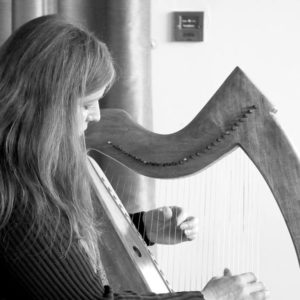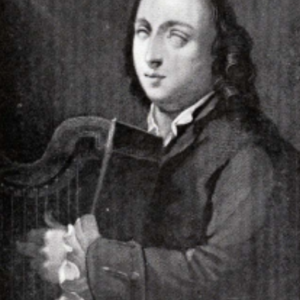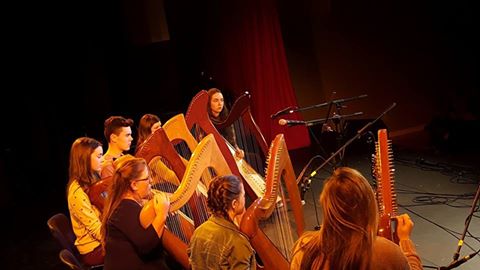Harp Introduction
‘But, all I ask of you, is that you will play upon my grave a lament to make tears flow …’
‘Acht amháin a iarraim ortsa,
Go seinnfidh tusa ar mo uaighse
Triamhain a bhainfidh deor ó ghruanna’
The poet MacCuarta to his friend the harper Mac Giolla Fhiondáin
ORIEL ARTS aims to bring to awareness the extent to which Oriel musicians, composers and poets have contributed to the harp tradition, and also to inspire contemporary instrumental musicians and singers to revisit local repertoire, inherited through oral and manuscript transmission.
There are comprehensive accounts on this ORIEL ARTS website of poets and harpers of Oriel; Carolan’s association with Oriel in place, people and composition, and new videos of music collected from Oriel harpers.
A Hidden Ulster gave the first comprehensive and chronological account of the harp tradition in Oriel (AHU pp. 215-40; pp. 337-57). With up to date research, ORIEL ARTS now builds on that information with emphasis on harp music, harpers and poets, collectors and repertoire.

Sylvia Crawford playing a copy of the Trinity harp, which is an HHSI Connemara Trinity, a basic copy of the Trinity harp, made by Ériú Harps.
Oriel is central to unravelling the story of the harp tradition in Ireland. Many of the leading harp music personalites, in collecting and playing, came from, or visited, the region including Edward Bunting, Arthur O’Neill and Carolan. There are at least ten names of Oriel poets and harpers identified with the harp, not including harpers from neighbouring counties who had Oriel songs and airs in their repertoire. Seven of them are given full attention on this site, as well as Carolan’s connection with Oriel, including harp songs and airs for Oriel patrons.
ORIEL ARTS collaborated with County Armagh harper, Sylvia Crawford, on research of a selection of airs and songs collected by Bunting from Oriel harpers. With each instrumental video, she gives a detailed analysis of the music manuscripts sourced by her, the process of editing and notation.
The harpers of Oriel would have played on an early wire strung harp, and the selected pieces here are played on a copy of the Patrick Quin, Otway Harp, filmed in summer 2016 in Mullaghban, County Armagh. (See also Oriel Harpers section for commentary on the instrument by Sylvia Crawford)
Harp Songs

Turlough O’Carolan the blind harper/composer who visited in Oriel
As well as Carolan’s three Louth songs for patrons and gentry: Betty MacNeill , Captain O’Neill and Lord Louth, with their words and music reconnected as song, there is an emerging category of song which is identifiable as harp-song. Written by recognised and anonymous poets, they are a song type which were likely sung to harp accompaniment. They are mellifluous in tone, sweet in melody, assonantal in metre and seductive in effect – intending to woo or flatter. They are, generally, unlike the mainstream love songs of the people.
There are two harp-songs in Oriel dating from the 17th century, known widely among harp players as, Charming Fair Eily and The Green Woods of Trugh. These were written/composed by local harper-poets: their lyrics are available in manuscripts and song collections, and their respective airs are found in the Bunting Collection in QUB. They are now back in the repertoire of singers following a renewed recording of them (Ceolaí Oirialla Cd 2017).

Patrick Byrne Oriel Harper
In A Hidden Ulster – people, songs and traditions of Oriel, (2003) the author was keen to acknowledge the continuity and interconnection between the harp and Gaelic song tradition. (AHU pp. 337-57). Although the unbroken oral tradition of transmitting harp music in Oriel had ended well before the death of harper Patrick Byrne in 1863, harp songs survived in the oral tradition, and harp tunes filtered into the general traditional music repertoire – written down in manuscript.
There is ample evidence that there had been a vibrant harp playing tradition in the region for centuries. We can glean from accounts, repertoires, references, songs and poetry anthologies that there was an interwoven connection between the literary, harp and song traditions in Oriel. The poets and harpers were interdependent on each other: supported each other; held bardic and harp contentions with each other; lamented each others deaths in song and harp music and socialised together.
Some of the poets wrote songs for harp accompaniment that were very different in style and metre from other categories of traditional songs of the people. There is evidence that one harper composed airs for the song-poems of another poet; that two harper-poets composed poems (probably sung to harp accompaniment), welcoming Carolan and Brigid Cruise to the Cooley peninsula; that airs of song-poems by well known Oriel poets were written down at the Belfast Harpers Assembly in 1792; that some poets were also harpers, and that poets sang their songs to harp accompaniment; that harpers sang in Irish to their own accompaniment; that there was an active Gaelic school of poetry and harp music along the borders of Louth and Armagh around the end of the 17th century.
With ongoing research, a significant number of poems are emerging as having been written as song – with airs, titles and lyrics of songs (hitherto only known as poems) found in the large corpus that is the Bunting Collection at QUB Belfast, and in other collections.
The metres and song form – mainly found in the Ulster tradition, rather than contemporary styles of traditional singing, are a key to the interpretation and phrasing of some harp airs noted by Edward Bunting and others from 1792 and later.
Cooperative research between practitioners and scholars in both genres could unlock some of the mysteries of the aesthetics of harp music and song forms in Ireland.
While many of the airs were written down from a small selection of harpers in Belfast from 1792 onward, further light can be cast on their context and interpretation by looking to the corpus of song.
The harp that once …
Harp playing is experiencing a renewal and vibrancy in the Oriel region, once again. It is worth noting that Oriel had the last Harp Society which was in Drogheda, founded in 1842 by Thomas Burke, who appointed Hugh Frazer as the teacher for the school in which there were 15 students and 12 harps. Frazer had been taught by Edward McBride who had been a pupil of Arthur O’Neill in Belfast. Harps ordered for the school were made in Drogheda. They were made from timber supplied by a Mr Ball of Ballsgrove House and made by Francis Flood, with harp students helping in the construction of their own harps.
Armagh is the birth town of Edward Bunting, and the early Irish wire strung harp is being taught again in Armagh by Sylvia Crawford, who is also a tutor at the unique annual Scoil na gCláirseach—Festival of Early Irish Harp in Kilkenny, directed by harper, Siobhán Armstrong, with its emphasis on performance, teaching, research and collaboration.

Senior Harp Ensemble Music Generation Louth taught by Deirdre Ní Bhuachalla.
At the celebrated, and hugely successful, Armagh Piper’s Club, the harp is being taught by Emer Mallon from County Armagh and Eilis Lavelle from County Monaghan. In County Louth, Deirdre Ní Bhuachalla is harp tutor with Music Generation Louth and Comhaltas Ceoltóirí Éireann in Dundalk.
Performance, teaching and tutor publications are the main features of the very successful Cairde na Cruite Summer School. Under the direction of harper Aibhlín McCrann, it is held annually in the hinterlands of Drogheda, at An Grianán in Termonfeckin in County Louth, not far from Carolan‘s birthplace in Nobber, County Meath, where an annual harp festival is held, and where the traditional harp is very successfully taught by Dearbhaill Finnegan of the Meath Harp Academy.

Dr Máire Uí Bhaoill speaking on Bunting’s collector, James Cody, at Éigse Oirialla 2016
Dr Máire Uí Bhaoill, who has completed a PhD thesis on James Cody, one of Edward Bunting’s collectors, gave a lecture on her research at Éigse Oirialla, in Omeath County Louth 2016. Her research outcome is being edited for publication.
DkIT County Louth lecturer in music and traditional harper, Helen Lawlor has co-edited, with Sandra Joyce of IWAMD in Limerick, a new book, Harp Studies’ which is a valuable new collection, presenting new research on the Irish harp.
Collecting, collaboration and performance has been a feature of Oriel harp tradition, and this continues at present with ongoing research on identifying harp-songs with lyrics and music, by Pádraigín Ní Uallacháin. This involves collaborative consultation and performance between singer and harper. Research by Sylvia Crawford on the repertoire of Patrick Quin – his life and times, is nearing completion, with illustrative talks being given by her in Oriel and beyond.
A platform for concert performance and illustrative research outcome is available at Éigse Oirialla and ORIEL ARTS.
The contemporary Irish harp is made in Omeath County Louth by Neville Mac Anna of Narrow Water Harps, serving its widespread enthusiastic renewal.
Oriel Arts © Pádraigín Ní Uallacháin CÉ 2020
